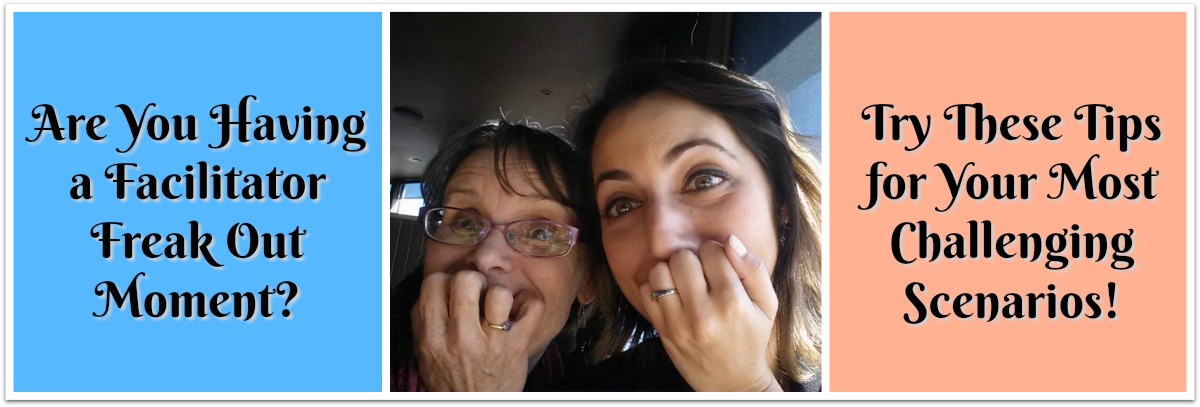6 Facilitator Styles That Will Keep You Out of Trouble!

 In this blog we will talk about our facilitator style and presence. These are the things you need to cultivate in yourself to effectively solicit meaningful participation or group engagement.
In this blog we will talk about our facilitator style and presence. These are the things you need to cultivate in yourself to effectively solicit meaningful participation or group engagement.
Personally, as I look back over 20 or more years of facilitating, I think my style has been one of the most important aspects of my work. It’s the thing people resonate most with. I’ve realized that the person I have become while cultivating my facilitator style is something that I am proud of. My journey as a professional facilitator has helped me grow as a human being in the way that I care for the world.
Therefore, it is incredibly important to think about how your style can be cultivated to have the positive impact you want on groups. Below I distinguish two parts to style – your ingrained or embedded style and your intentional or cultivated style.
Embedded Style – Bring Your Authentic Self to the Group
How would you describe yourself when you’re facilitating? Are you serious, high energy, full of humor, talkative, peaceful, thoughtful? These are traits or qualities that characterize what I’ll call your general authentic style. These things don’t change a lot from one group to another. They are what you have cultivated over a lifetime as what some people call personality, personal qualities or others call embedded patterns of behavior. To be simple, I’m not going to talk too much about these general qualities that you carry around in all aspects of your life. I do, however, think that even some of these general qualities that are part of your authentic self can be modified when a group needs something different from you. That requires a fair bit of intentionality on your part to do that. For example, my style is often characterized as calm, well organized, depth of knowledge, and welcoming. Generally, these qualities serve most groups well. However, being super calm wouldn’t work well for a group that just learned they received $10 million in new unexpected funding. In this case, I’d probably have to pull out my secret stash of high energy and enthusiasm and be ready to “party” or celebrate with them!
Intentional Style – Cultivate These Qualities to be Effective
There are a host of really important qualities that you want to cultivate beyond your embedded style. Below we outline six key styles that can be used in challenging scenarios to demonstrate how you can adapt your style to the group.
Pace and energy

The scene: Imagine you are facilitating a group of scientists who are methodical and love spending a lot of time analyzing facts and data. You only have 3 hours left and they said they wanted to make a decision. At their current rate of analysis, it looks like it will take 3 weeks to get to the decision!
The style needed: This is where you adopt a firm, fast-paced, and energetic style. You give them a series of provocative series of questions with only 3-5 minutes to answer each one. You reassure them that they will get a reasonably high quality result. You remind them that they have the collective wisdom of all these great scientific minds in the room. You have just modified your style to handle the crisis of getting “stuck in the data mud”.
Tone of Voice/Facial Gestures

The scene: You are completely frustrated with some members of the group. They have been ignoring under represented people in the room. You are not sure how to interrupt this pattern of dominant behavior.
The style needed: You use your tone of voice to be playful and non-judging. For example you might say, “I notice there are certain good, loving people in this room that we’ve heard from quite a lot (your voice can be affectionate and teasing, you might even try to get people to laugh). I think you probably know who you are if you’ve been talking quite a bit. I’m wondering if you could now look thoughtful rather than speaking for the next little while. I’m pretty sure there are some other great thoughts in the room that all of us would benefit from hearing. I am now inviting someone who has not yet had a turn to speak, to do so.” (Put on your most welcoming smile and look at some of the under represented participants with great anticipation. Keep your tone light.)
Content Neutrality

The scene: You are an internal facilitator to your own organization. You have a great amount of knowledge about the topic that the group is discussing. You feel like they maybe are missing a key point.
The style needed: Option 1 – you step aside and say, “For a moment, I’m taking off my facilitator hat and I would like to give you a piece of information that has not been offered yet in the hopes that it may contribute to the discussion.” Option 2 – You tell the group that you have a strong opinion and can no longer be neutral. Ask if someone else will facilitate this piece. Option 3 – You maintain an interested, calm face knowing that the group is wise and eventually they will come to a decision that will include the best thinking of the group. In other words, you let go of the notion that the group absolutely needs to hear what you have to say for them to be successful. One way to avoid this entire scenario is to provide your thinking in writing before the meeting begins and ask one or two people attending the meeting to bring those points forward at the appropriate time.
Preparation

The scene: You have just learned that you are facilitating a meeting in 2 days (or 2 hours!) and the subject matter is not one with which you are familiar. You normally prepare a great deal for events.
The style needed: You are going to need to “fake” confidence and use a transparent style. See more on these below. However, in reality you can still be a great gift to the group even when you don’t have you usual amount of preferred preparation time. Here are a few tips…Be sure to talk to a few key people who will attend the meeting and find out what results or outcomes they expect to achieve. Gather up a variety of props that would cover a number of different methods and tools that could help you be successful in achieving these outcomes. In addition, I find it helpful at this point to use tools that I know well. That keeps my confidence level high. Remind yourself that you are a good thinker and you can rely on the group when you are unsure. During the meeting use these phrases often, “I’m wondering what the rest of the group thinks will be most helpful here”; “Let’s take a break” (and take this time to solicit ideas from trusted group members about how to handle a situation); or say, “I have two ideas that I’d like to run by you as process options – tell me which will work better for you as a group.” In other words, be flexible and trust yourself and good process.
Transparency and Honesty

The scene: The group seems to be avoiding talking about a particular issue you know is important to them.
The style needed: Try saying, “I’ve heard you talk about this issue before and I’m wondering why no one has raised it thus far. Who would be willing to tell me what is really going on? I’m guessing that if this issue does not get addressed many of you will leave this room feeling discouraged and that this meeting was a waste of time.” Then sit down, be quiet, look expectant, calm and relaxed and wait for someone to say something.
Confidence

The scene: You have been asked to facilitate a topic or a group which you are nervous about. You feel that you will be unable to understand their organizational terminology on the topic or understand their field in general.
The style needed: Admit to the group up front that many times you will not know what their acronyms are or what the topic is about. Reassure them that you do not normally need this information because you are the process expert, not a content expert. And, tell them if you are not sure, you will ask the group whether they need an explanation to follow the discussion. Remember, you can still be a good facilitator even if you have no idea what the group is talking about! I remember one timelining exercise I did where almost every 1/2 sheet on the sticky wall was an acronym.
I just read them out and laughed saying, “I am assuming you know exactly what these acronyms mean. But if you do not please ask and the group that wrote the card will explain.”
– – – – – – – – – – – – – – – – – – – – – – – – – – – – – – – – – – – – – – –
Feedback
What additional scenarios would you add and how would you adapt your style to deal with your own scenario? Please share your comment below or add to our Facebook page.


Love this. Thank you, Barb. Very practical scene.
very interesting AND informative I have learned a lot. I am due to go on a three day course and am researching this subject.
Barbara, this is precise and succinct, direct to the point. It has widened by horizons. Thank you